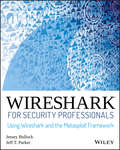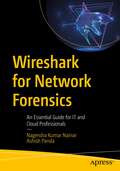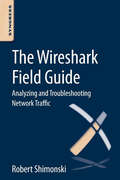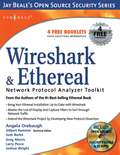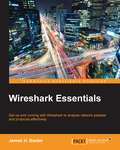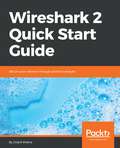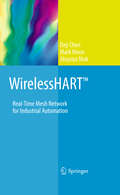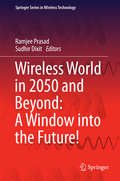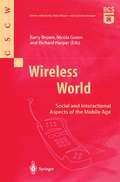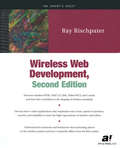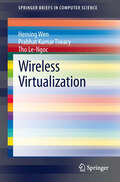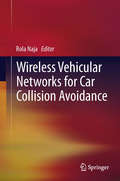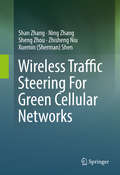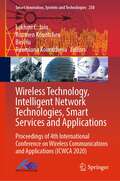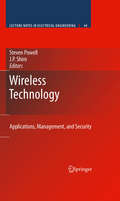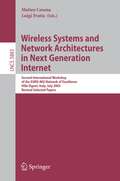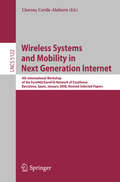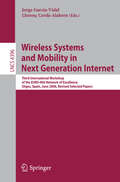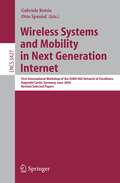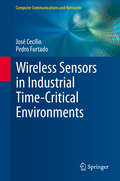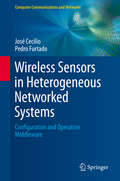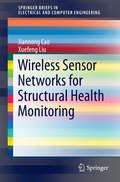- Table View
- List View
Wireshark for Security Professionals: Using Wireshark and the Metasploit Framework
by Jessey Bullock Jeff T. ParkerMaster Wireshark to solve real-world security problems If you don’t already use Wireshark for a wide range of information security tasks, you will after this book. Mature and powerful, Wireshark is commonly used to find root cause of challenging network issues. This book extends that power to information security professionals, complete with a downloadable, virtual lab environment. Wireshark for Security Professionals covers both offensive and defensive concepts that can be applied to essentially any InfoSec role. Whether into network security, malware analysis, intrusion detection, or penetration testing, this book demonstrates Wireshark through relevant and useful examples. Master Wireshark through both lab scenarios and exercises. Early in the book, a virtual lab environment is provided for the purpose of getting hands-on experience with Wireshark. Wireshark is combined with two popular platforms: Kali, the security-focused Linux distribution, and the Metasploit Framework, the open-source framework for security testing. Lab-based virtual systems generate network traffic for analysis, investigation and demonstration. In addition to following along with the labs you will be challenged with end-of-chapter exercises to expand on covered material. Lastly, this book explores Wireshark with Lua, the light-weight programming language. Lua allows you to extend and customize Wireshark’s features for your needs as a security professional. Lua source code is available both in the book and online. Lua code and lab source code are available online through GitHub, which the book also introduces. The book’s final two chapters greatly draw on Lua and TShark, the command-line interface of Wireshark. By the end of the book you will gain the following: Master the basics of Wireshark Explore the virtual w4sp-lab environment that mimics a real-world network Gain experience using the Debian-based Kali OS among other systems Understand the technical details behind network attacks Execute exploitation and grasp offensive and defensive activities, exploring them through Wireshark Employ Lua to extend Wireshark features and create useful scripts To sum up, the book content, labs and online material, coupled with many referenced sources of PCAP traces, together present a dynamic and robust manual for information security professionals seeking to leverage Wireshark.
Wireshark for Security Professionals: Using Wireshark and the Metasploit Framework
by Jessey Bullock Jeff T. ParkerMaster Wireshark to solve real-world security problems If you don’t already use Wireshark for a wide range of information security tasks, you will after this book. Mature and powerful, Wireshark is commonly used to find root cause of challenging network issues. This book extends that power to information security professionals, complete with a downloadable, virtual lab environment. Wireshark for Security Professionals covers both offensive and defensive concepts that can be applied to essentially any InfoSec role. Whether into network security, malware analysis, intrusion detection, or penetration testing, this book demonstrates Wireshark through relevant and useful examples. Master Wireshark through both lab scenarios and exercises. Early in the book, a virtual lab environment is provided for the purpose of getting hands-on experience with Wireshark. Wireshark is combined with two popular platforms: Kali, the security-focused Linux distribution, and the Metasploit Framework, the open-source framework for security testing. Lab-based virtual systems generate network traffic for analysis, investigation and demonstration. In addition to following along with the labs you will be challenged with end-of-chapter exercises to expand on covered material. Lastly, this book explores Wireshark with Lua, the light-weight programming language. Lua allows you to extend and customize Wireshark’s features for your needs as a security professional. Lua source code is available both in the book and online. Lua code and lab source code are available online through GitHub, which the book also introduces. The book’s final two chapters greatly draw on Lua and TShark, the command-line interface of Wireshark. By the end of the book you will gain the following: Master the basics of Wireshark Explore the virtual w4sp-lab environment that mimics a real-world network Gain experience using the Debian-based Kali OS among other systems Understand the technical details behind network attacks Execute exploitation and grasp offensive and defensive activities, exploring them through Wireshark Employ Lua to extend Wireshark features and create useful scripts To sum up, the book content, labs and online material, coupled with many referenced sources of PCAP traces, together present a dynamic and robust manual for information security professionals seeking to leverage Wireshark.
Wireshark for Network Forensics: An Essential Guide for IT and Cloud Professionals
by Nagendra Kumar Nainar Ashish PandaWith the advent of emerging and complex technologies, traffic capture and analysis play an integral part in the overall IT operation. This book outlines the rich set of advanced features and capabilities of the Wireshark tool, considered by many to be the de-facto Swiss army knife for IT operational activities involving traffic analysis. This open-source tool is available as CLI or GUI. It is designed to capture using different modes, and to leverage the community developed and integrated features, such as filter-based analysis or traffic flow graph view. You'll start by reviewing the basics of Wireshark, and then examine the details of capturing and analyzing secured application traffic such as SecureDNS, HTTPS, and IPSec. You'll then look closely at the control plane and data plane capture, and study the analysis of wireless technology traffic such as 802.11, which is the common access technology currently used, along with Bluetooth. You'll also learn ways to identify network attacks, malware, covert communications, perform security incident post mortems, and ways to prevent the same. The book further explains the capture and analysis of secure multimedia traffic, which constitutes around 70% of all overall internet traffic. Wireshark for Network Forensics provides a unique look at cloud and cloud-native architecture-based traffic capture in Kubernetes, Docker-based, AWS, and GCP environments. What You'll LearnReview Wireshark analysis and network forensicsStudy traffic capture and its analytics from mobile devicesAnalyze various access technology and cloud trafficWrite your own dissector for any new or proprietary packet formatsCapture secured application traffic for analysisWho This Book Is ForIT Professionals, Cloud Architects, Infrastructure Administrators, and Network/Cloud Operators
The Wireshark Field Guide: Analyzing and Troubleshooting Network Traffic
by Robert ShimonskiThe Wireshark Field Guide provides hackers, pen testers, and network administrators with practical guidance on capturing and interactively browsing computer network traffic. Wireshark is the world's foremost network protocol analyzer, with a rich feature set that includes deep inspection of hundreds of protocols, live capture, offline analysis and many other features. The Wireshark Field Guide covers the installation, configuration and use of this powerful multi-platform tool. The book give readers the hands-on skills to be more productive with Wireshark as they drill down into the information contained in real-time network traffic. Readers will learn the fundamentals of packet capture and inspection, the use of color codes and filters, deep analysis, including probes and taps, and much more. The Wireshark Field Guide is an indispensable companion for network technicians, operators, and engineers.Learn the fundamentals of using Wireshark in a concise field manual Quickly create functional filters that will allow you to get to work quickly on solving problems Understand the myriad of options and the deep functionality of Wireshark Solve common network problems Learn some advanced features, methods and helpful ways to work more quickly and efficiently
Wireshark & Ethereal Network Protocol Analyzer Toolkit
by Angela Orebaugh Gilbert Ramirez Jay BealeEthereal is the #2 most popular open source security tool used by system administrators and security professionals. This all new book builds on the success of Syngress’ best-selling book Ethereal Packet Sniffing.Wireshark & Ethereal Network Protocol Analyzer Toolkit provides complete information and step-by-step Instructions for analyzing protocols and network traffic on Windows, Unix or Mac OS X networks. First, readers will learn about the types of sniffers available today and see the benefits of using Ethereal. Readers will then learn to install Ethereal in multiple environments including Windows, Unix and Mac OS X as well as building Ethereal from source and will also be guided through Ethereal’s graphical user interface. The following sections will teach readers to use command-line options of Ethereal as well as using Tethereal to capture live packets from the wire or to read saved capture files. This section also details how to import and export files between Ethereal and WinDump, Snort, Snoop, Microsoft Network Monitor, and EtherPeek. The book then teaches the reader to master advanced tasks such as creating sub-trees, displaying bitfields in a graphical view, tracking requests and reply packet pairs as well as exclusive coverage of MATE, Ethereal’s brand new configurable upper level analysis engine. The final section to the book teaches readers to enable Ethereal to read new Data sources, program their own protocol dissectors, and to create and customize Ethereal reports.Ethereal is the #2 most popular open source security tool, according to a recent study conducted by insecure.orgSyngress' first Ethereal book has consistently been one of the best selling security books for the past 2 years
Wireshark Essentials
by James H. BaxterThis book is aimed at IT professionals who want to develop or enhance their packet analysis skills. Basic familiarity with common network and application services terms and technologies is assumed; however, expertise in advanced networking topics or protocols is not required. Readers in any IT field can develop the analysis skills specifically needed to complement and support their respective areas of responsibility and interest.
Wireshark 2 Quick Start Guide: Secure your network through protocol analysis
by Charit MishraProtect your network as you move from the basics of the Wireshark scenarios to detecting and resolving network anomalies. Key Features Learn protocol analysis, optimization and troubleshooting using Wireshark, an open source tool Learn the usage of filtering and statistical tools to ease your troubleshooting job Quickly perform root-cause analysis over your network in an event of network failure or a security breach Book Description Wireshark is an open source protocol analyser, commonly used among the network and security professionals. Currently being developed and maintained by volunteer contributions of networking experts from all over the globe. Wireshark is mainly used to analyze network traffic, analyse network issues, analyse protocol behaviour, etc. - it lets you see what's going on in your network at a granular level. This book takes you from the basics of the Wireshark environment to detecting and resolving network anomalies. This book will start from the basics of setting up your Wireshark environment and will walk you through the fundamentals of networking and packet analysis. As you make your way through the chapters, you will discover different ways to analyse network traffic through creation and usage of filters and statistical features. You will look at network security packet analysis, command-line utilities, and other advanced tools that will come in handy when working with day-to-day network operations. By the end of this book, you have enough skill with Wireshark 2 to overcome real-world network challenges. What you will learn Learn how TCP/IP works Install Wireshark and understand its GUI Creation and Usage of Filters to ease analysis process Understand the usual and unusual behaviour of Protocols Troubleshoot network anomalies quickly with help of Wireshark Use Wireshark as a diagnostic tool for network security analysis to identify source of malware Decrypting wireless traffic Resolve latencies and bottleneck issues in the network Who this book is for If you are a security professional or a network enthusiast who is interested in understanding the internal working of networks and packets, then this book is for you. No prior knowledge of Wireshark is needed.
Wireshark 2 Quick Start Guide: Secure your network through protocol analysis
by Charit MishraProtect your network as you move from the basics of the Wireshark scenarios to detecting and resolving network anomalies. Key Features Learn protocol analysis, optimization and troubleshooting using Wireshark, an open source tool Learn the usage of filtering and statistical tools to ease your troubleshooting job Quickly perform root-cause analysis over your network in an event of network failure or a security breach Book Description Wireshark is an open source protocol analyser, commonly used among the network and security professionals. Currently being developed and maintained by volunteer contributions of networking experts from all over the globe. Wireshark is mainly used to analyze network traffic, analyse network issues, analyse protocol behaviour, etc. - it lets you see what's going on in your network at a granular level. This book takes you from the basics of the Wireshark environment to detecting and resolving network anomalies. This book will start from the basics of setting up your Wireshark environment and will walk you through the fundamentals of networking and packet analysis. As you make your way through the chapters, you will discover different ways to analyse network traffic through creation and usage of filters and statistical features. You will look at network security packet analysis, command-line utilities, and other advanced tools that will come in handy when working with day-to-day network operations. By the end of this book, you have enough skill with Wireshark 2 to overcome real-world network challenges. What you will learn Learn how TCP/IP works Install Wireshark and understand its GUI Creation and Usage of Filters to ease analysis process Understand the usual and unusual behaviour of Protocols Troubleshoot network anomalies quickly with help of Wireshark Use Wireshark as a diagnostic tool for network security analysis to identify source of malware Decrypting wireless traffic Resolve latencies and bottleneck issues in the network Who this book is for If you are a security professional or a network enthusiast who is interested in understanding the internal working of networks and packets, then this book is for you. No prior knowledge of Wireshark is needed.
Wireshark 2 Quick Start Guide: Secure Your Network Through Protocol Analysis
by Charit MishraWireshark is a powerful tool for network analysis, a combination of Kali Linux and the Metasploit framework. Wireshark is used to analyze the amount of data that flows through a network - it lets you see what's going on in your network. This book takes you from the basics of the Wireshark environment to detecting and resolving network anomalies.
WirelessHART™: Real-Time Mesh Network for Industrial Automation
by Deji Chen Mark Nixon Aloysius MokThe process control industry has seen generations of technology advancement, from pneumatic communication to electrical communication to electronic c- munication, from centralized control to distributed control. At the center of today’s distributed control systems are operator workstations. These operator wo- stations provide the connection between those overseeing and running plant operations to the process itself. With each new generation of products the operator workstation has become increasingly more intelligent. Newer applications provide advanced alarming, control, and diagnostics. Behind all of these applications are smarter devices. These smart devices provide greater process insight, reduce en- neering costs, and contribute to improving the overall operational performance of the plant. Smart devices include advanced diagnostics that can report the health of the device and in many cases, the health of the process that the device is connected to. It is not uncommon for smart devices to include diagnostics that can detect plugged lines, burner flame instability, agitator loss, wet gas, orifice wear, leaks, and cavitations. These devices tell the user how well they are operating and when they need maintenance. Improvements in sensor technology and diagnostics have lead to a large variety of smart devices. So how do users connect the capabilities of these smart devices to their existing control system infrastructures? The answer is wireless. Wireless technology has matured to the point that it now can be safely applied in industrial control, monitor, and asset management applications.
Wireless World in 2050 and Beyond: A Window into the Future! (Springer Series in Wireless Technology)
by Ramjee Prasad Sudhir DixitThis book gathers visionary ideas from leading academics and scientists to predict the future of wireless communication and enabling technologies in 2050 and beyond. The content combines a wealth of illustrations, tables, business models, and novel approaches to the evolution of wireless communication. The book also provides glimpses into the future of emerging technologies, end-to-end systems, and entrepreneurial and business models, broadening readers’ understanding of potential future advances in the field and their influence on society at large
Wireless World: Social and Interactional Aspects of the Mobile Age (Computer Supported Cooperative Work)
by RichardHarper NicolaGreen BarryBrownDespite the massive growth of mobile technologies, very little research has been done on how these technologies influence human interaction. Most of the published work in this area focuses on technological aspects and not on the social implications the technology is having on society. This book aims to fill this gap by providing an overview of these issues. It identifies the major trends, discusses the main claims made about the mobile age, and looks at issues which affect design, usability and evaluation. This unique look at the mobile age provides many interesting and important insights and will appeal to anyone designing, testing, or studying mobile devices.
Wireless Web Development
by Ray RischpaterRischpater's second edition has new coverage of HTML, WAP 2.0, XML, Palm's WCA and iMode in detail and improves the text of the first edition with time-tested information.
Wireless Virtualization (SpringerBriefs in Computer Science)
by Heming Wen Prabhat Kumar Tiwary Tho Le-NgocThis SpringerBriefs is an overview of the emerging field of wireless access and mobile network virtualization. It provides a clear and relevant picture of the current virtualization trends in wireless technologies by summarizing and comparing different architectures, techniques and technologies applicable to a future virtualized wireless network infrastructure. The readers are exposed to a short walkthrough of the future Internet initiative and network virtualization technologies in order to understand the potential role of wireless virtualization in the broader context of next-generation ubiquitous networks. Three main wireless virtualization perspectives are explored, along with the potential challenges and requirements of a sustainable wireless virtualization framework. Finally, it presents an example of a multi-perspective wireless virtualization framework. The readers learn the latest concepts in the application of wireless virtualization as well as its relationship with cutting-edge wireless technologies such as software-defined radio (SDR) and cognitive radio.
Wireless Vehicular Networks for Car Collision Avoidance
by Rola NajaWireless Vehicular Networks for Car Collision Avoidance focuses on the development of the ITS (Intelligent Transportation Systems) in order to minimize vehicular accidents. The book presents and analyses a range of concrete accident scenarios while examining the causes of vehicular collision and proposing countermeasures based on wireless vehicular networks.The book also describes the vehicular network standards and quality of service mechanisms focusing on improving critical dissemination of safety information. With recommendations on techniques and protocols to consider when improving road safety policies in order to minimize crashes and collision risks.
Wireless Traffic Steering For Green Cellular Networks
by Shan Zhang Ning Zhang Sheng Zhou Zhisheng Niu Xuemin (Sherman) ShenThis book introduces wireless traffic steering as a paradigm to realize green communication in multi-tier heterogeneous cellular networks. By matching network resources and dynamic mobile traffic demand, traffic steering helps to reduce on-grid power consumption with on-demand services provided. This book reviews existing solutions from the perspectives of energy consumption reduction and renewable energy harvesting. Specifically, it explains how traffic steering can improve energy efficiency through intelligent traffic-resource matching. Several promising traffic steering approaches for dynamic network planning and renewable energy demand-supply balancing are discussed. This book presents an energy-aware traffic steering method for networks with energy harvesting, which optimizes the traffic allocated to each cell based on the renewable energy status. Renewable energy demand-supply balancing is a key factor in energy dynamics, aimed at enhancing renewable energy sustainability to reduce on-grid energy consumption. Dynamic network planning adjusts cell density with traffic variations to provide on-demand service, which reduces network power consumption with quality of service provisioning during off-peak hours. With intra- or inter-tier traffic steering, cell density is dynamically optimized with regards to the instant traffic load for conventional homogeneous and multi-tier heterogeneous cellular networks, respectively. This book is beneficial for researchers and graduate students interested in traffic management and future wireless networking.
Wireless Technology, Intelligent Network Technologies, Smart Services and Applications: Proceedings of 4th International Conference on Wireless Communications and Applications (ICWCA 2020) (Smart Innovation, Systems and Technologies #258)
by Lakhmi C. Jain Roumen Kountchev Bin Hu Roumiana KountchevaThis book gathers selected papers presented at the 4th International Conference on Wireless Communications and Applications (ICWCA 2020), held at Hainan University, China. The second volume will involve research works aimed at the contemporary applications: emerging wireless/mobile applications, context and location-aware wireless services; wireless telemedicine and e-health services; intelligent transportation systems; RFID technology and application; cognitive radio and sensor-based applications; content distribution in wireless home environment and many others.
Wireless Technology: Applications, Management, and Security (Lecture Notes in Electrical Engineering #44)
by Steven Powell J. P. ShimWireless technology and handheld devices are dramatically changing the degrees of interaction throughout the world, further creating a ubiquitous network society. The emergence of advanced wireless telecommunication technologies and devices in today’s society has increased accuracy and access rate, all of which are increasingly essential as the volume of information handled by users expands at an accelerated pace. The requirement for mobility leads to increasing pressure for applications and wireless systems to revolve around the concept of continuous communication with anyone, anywhere, and anytime. With the wireless technology and devices come ?exibility in network design and quicker deployment time. Over the past decades, numerous wireless telecommu- cation topics have received increasing attention from industry professionals, a- demics, and government agencies. Among these topics are the wireless Internet; multimedia; 3G/4G wireless networks and systems; mobile and wireless network security; wireless network modeling, algorithms, and simulation; satellite based s- tems; 802.11x; RFID; and broadband wireless access.
Wireless Systems and Network Architectures in Next Generation Internet: Second International Workshop of the EURO-NGI Network of Excellence, Villa Vigoni, Italy, July 13-15, 2005, Revised Selected Papers (Lecture Notes in Computer Science #3883)
by Matteo Cesana Luigi FrattaThis book constitutes the refereed post-proceedings of the second international joint workshops on Wireless and Mobility and on New Trends in Network Architectures and Services organized by the European Network of Excellence on Next Generation Internet, EURO-NGI 2005. The 19 revised full research papers presented together with 1 invited talk are organized in topical sections on wireless solutions, QoS support in next generation networks, and peer to peer architectures and algorithms.
Wireless Systems and Mobility in Next Generation Internet: 4th International Workshop of the EuroNGI/EuroFGI Network of Excellence Barcelona, Spain, January 16-18, 2008. Revised Selected Papers (Lecture Notes in Computer Science #5122)
by Llorenç Cerdà-AlabernWireless Systems and Mobility in Next Generation Internet: Third International Workshop of the EURO-NGI Network of Excellence, Sitges, Spain, June 6-9, 2006, Revised Selected Papers (Lecture Notes in Computer Science #4396)
by Jorge García-Vidal Llorenc Cerdà-AlabernThis book is the thoroughly refereed post-proceedings of the Third International Workshop on Wireless and Mobility organized by the European Network of Excellence on Next Generation Internet held in Spain, June 2006. It covers WLAN characterization, vehicular networks, WLAN and sensor networks protocols, QoS and routing in ad-hoc networks, heterogeneous networks, resource management in cellular networks, TCP in wireless, and mobility agents.
Wireless Systems and Mobility in Next Generation Internet: First International Workshop of the EURO-NGI Network of Excellence, Dagstuhl Castle, Germany, June 7-9, 2004, Revised Selected Papers (Lecture Notes in Computer Science #3427)
by Gabriele Kotsis Otto SpaniolThe Internet is subject to permanent modi?cations and to continuous restr- turing. This is primarily due to the tremendous rise in demand for bandwidth by the ever increasing number of users. When compared to the early years of the Internet the quality of the services o?ered had to be signi?cantly improved in di?erent respects (delay, network and service availability, jitter,. . . )inorder to satisfy the needs of many new applications. Within the last decade two new developments have contributed to many new opportunities, as well as to a need for intensive research and development: – the increased mobility of users together with the desire for ubiquitous hi- quality access to all o?ered services, at reasonable cost; – the use of wireless communication. Despite their relatively low capacity (when compared with ?xed backbone n- works) the use of radio links supports the ubiquitous availability of Internet services in a quasiperfect way. A considerable amount of research and development activities are currently - ing on worldwide in order to adapt Internet services to the particular needs of mobile users and of wireless communication links. These questions were - tensively discussed at the ?rst workshop organized by the EURO-NGI Network of Excellence (‘Next Generation Internet’), which has been funded by the - ropean Union since January 2004 under their IST programme.
Wireless Sensors in Industrial Time-Critical Environments (Computer Communications and Networks)
by José Cecílio Pedro FurtadoThis book introduces the fundamentals of DCS, and shows how to include wireless technology in their design while guaranteeing the desired operation characteristics. The text also presents insights and results gained from extensive practical experience in implementing and testing systems within a specific industrial setting. Features: examines the operations that the DCS implements, covering human-machine interfaces, diagnostics and maintenance interfaces, and controllers; discusses industrial control system and wireless network protocols; reviews scheduling in wireless sensor networks; describes a latency model for heterogeneous DCS with wired and wireless parts, that predicts monitoring, command, and closed loop latencies; explains how to plan operation timings systematically; introduces measures and metrics for performance monitoring and debugging, and describes how to add these to a system; presents experimental results to validate the planning approach, based on an application test-bed.
Wireless Sensors in Heterogeneous Networked Systems: Configuration and Operation Middleware (Computer Communications and Networks)
by José Cecílio Pedro FurtadoThis book presents an examination of the middleware that can be used to configure and operate heterogeneous node platforms and sensor networks. The middleware requirements for a range of application scenarios are compared and analysed. The text then defines middleware architecture that has been integrated in an approach demonstrated live in a refinery. Features: presents a thorough introduction to the major concepts behind wireless sensor networks (WSNs); reviews the various application scenarios and existing middleware solutions for WSNs; discusses the middleware mechanisms necessary for heterogeneous WSNs; provides a detailed examination of platform-agnostic middleware architecture, including important implementation details; investigates the programming paradigms for WSNs, and for heterogeneous sensor networks in general; describes the results of extensive experimentation and testing, demonstrating that the generic architecture is viable for implementation on multiple platforms.
Wireless Sensor Networks for Structural Health Monitoring (SpringerBriefs in Electrical and Computer Engineering #0)
by Jiannong Cao Xuefeng LiuThis brief covers the emerging area of wireless sensor network (WSN)-based structural health monitoring (SHM) systems, and introduces the authors’ WSN-based platform called SenetSHM. It helps the reader differentiate specific requirements of SHM applications from other traditional WSN applications, and demonstrates how these requirements are addressed by using a series of systematic approaches. The brief serves as a practical guide, explaining both the state-of-the-art technologies in domain-specific applications of WSNs, as well as the methodologies used to address the specific requirements for a WSN application. In particular, the brief offers instruction for problem formulation and problem solving based on the authors’ own experiences implementing SenetSHM. Seven concise chapters cover the development of hardware and software design of SenetSHM, as well as in-field experiments conducted while testing the platform. The brief’s exploration of the SenetSHM platform is a valuable feature for civil engineers designing their own similar SHM products, and the various concrete examples of problem formulation and algorithm design will make this an essential read for practitioners, researchers and students alike.
